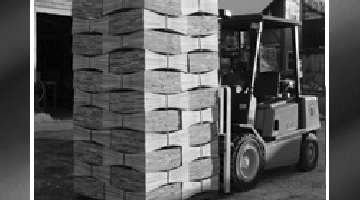Capitalizing on Cedar Shingles
by Judith M. Powell
A Family Enterprise in Top Notch Products
“Imagine, just 10 miles from the capital of Maine, one of the largest cedar shingle mills left in the state operates full bore in an area where relatively little cedar grows,” Peter Lammert, stewardship forester of the Maine Forest Service, remarks. “Fine home builders are reverting to materials used by early settlers who rived 3-foot-long shakes from virgin cedar to keep the weather out of their log cabins,” he adds. The Longfellow family of Windsor, Maine, is targeting this specialty niche.
Eighteen years ago, Jim and Tammy Longfellow were young and enthusiastic about starting their own business. Jim loved the idea of sawing shingles. The operation Tammy foresaw would support and weave around family, their children’s educational schedules and a centered home life.

The mill’s reputation for quality is firmly established, gaining a far-reaching market that stretches throughout New England and along the East Coast, south to Florida and as far west as Colorado. Many major lumber yards in Maine reserve shingles far in advance for customers who want top-quality or special siding for high-end housing developments or vacation homes. Getting to this point took more than just a love of sawing shingles. Business acumen and consistent quality are Longfellow trademarks. “Our focus is on quality. Our customers get a good measure every time and our shingles are sawn as close to perfection as possible,” Longfellow explains.
Assuring quality and “good measure” are important guarantees the family stands by. Every shingle that the Longfellows saw is scrutinized by hand inspection along the finishing process. The process starts with debarking the log. Logs are then cut into blocks, and the blocks are placed in the carriage, which reciprocates back and forth, feeding the block into the shingle saw. After the log’s outer slab has been sliced away, the shingle sawyer works to get the maximum number of shingle cuts out of each block. The sawyer edges or trims the sides of each shingle and then grades and sorts the sawn shingles according to knots or defects—all fast-paced, rapid-fire motion. Shingle grades help customers decide their preference for cost and how rustic a look they want.


The next step of assuring quality is the re-squaring and re-butting process. Each shingle is placed by hand and trimmed to have the sides trimmed parallel, perpendicular to the butt edge. “Our shingles are perfectly square because we have the only machine in the state of Maine that re-butts and re-squares every shingle,” Longfellow explains. When shingles are perfectly square they can go on faster and result in a smooth application of roofing or siding, and this saves labor cost. Custom orders for special projects in all types of climates requiring various lengths and thicknesses are in steady demand. From Cape Cod cottages to Hilton Head beach houses, demand keeps growing and orders keep coming from farther and farther away. This is in part following consumer trends: value-driven desire for green products that reduce environmental degradation. “Twenty years ago vinyl siding was popular,” Longfellow says, but this trend has turned around. Now, 90 percent of top-end houses want wood siding, “because of aesthetics and enduring value.” Energy efficiency is another reason why consumers select wood shingles. R-value, the measure of the resistance of building materials to the flow of heat, shows that wood shingles have higher R-value ratings than aluminum or vinyl, thus providing better thermal insulation.



“Cedar is a funny beast,” says Lammert. “There always has been a demand for it,” explaining that 17 million feet of cedar sawlogs were exported from Maine in 2006, mostly to Quebec Province. “Much of the old-growth, big-diameter solid trees, good for dimensional lumber, have been cut, leaving smaller stems which primarily go for poles and fence posts.” The diameter of the log and how solid it is determine usage—whether for lumber, shingles, posts or poles. Cedar naturally regenerates in swamps and therefore cold weather, which freezes the ground, is needed for harvesting. Cedar trees growing in wet ground have “wet feet” and hollow centers versus cedar growing on hillsides, which is usually sound and not rotten, he explains. “A 28-inch-diameter tree with a 14-inch rotten hole in the middle [which he calls a “culvert” log] can saw out clear shingles because the wood around the hole is knot-free.” Lammert knows the industry well, after spending 30 years as utilization and marketing forester for the state of Maine.
Nearly all of the logs that Longfellow buys are harvested using sustainable forestry practices. Fuel consumed transporting Maine logs is much less than importing western red cedar from Washington state or western Canada, making Longfellow’s Maine-grown product more environmentally friendly. Loads of cedar logs delivered to Longfellow’s Mill come mixed in sizes and value, delivered by local loggers and by contractors who haul for land management companies.
To capture more of the market this year, Longfellow added staining and finishing options. Customers choose the color, and the treatment is applied prior to shipping. To apply the finish, the shingles are unbundled and separated. Each shingle is dipped and the edges are hand-rolled. They dry in a building heated by a waste fuel boiler and then are boxed and shipped and not re-bundled to protect the color application. Natural unpainted shingles are tightly bundled and sold by the square consisting of four 20-inch-wide bundles. A square will cover at least 100 square feet of wall or roof with 5 inches exposed to the weather. Longfellow’s assures more square footage than typical bundles sold by most commercial mills, which mass-produce on a larger scale—thus the “good measure” clause the operation guarantees. This is accomplished by carefully packing each shingle to minimize air space between the shingles in each row.


The mill makes use of all byproducts. Bark and edging pieces are ground into cedar bark mulch. Shingles less than 3 inches wide are bundled and sold as shims for installing doors, windows or other carpentry projects. Bundles of slabs are sold as kindling or campfire wood, the tops of stems as fence posts and shingle hair and sawdust to local farms as animal bedding and garden mulch.
The family enterprise also operates Longfellow’s Hydroseeding business. Starting after spring thaw and after rural road postings against heavy loads come down, Tammy kicks into gear. In keeping with their doggedness for quality, only the best ingredients go into the mix of fertilizer, seed and fiber mulch. “What I put in my tank is the best I can buy,” Tammy says. Hydro-seeding keeps one truck on the road throughout the season with another backup truck in the wings so that mechanical breakdowns don’t delay deliveries. Only word-of-mouth advertising and two trade show promotions keep the schedule full. Tammy books jobs only a few days ahead.


These dual operations have served this hard-working family well. Their son Andy works various jobs in the mill, and their daughter Emily, at college in Washington state, spends summers helping out. Daughter Katie works in the mill re-butting and re-squaring or bundling shingles, plus other tasks where extra hands are needed.
The Longfellows hire three full-time sawyers year-round, plus up to four part-time workers seasonally in addition to family. Longfellow has his eye on expanding the southern market by increasing production and productivity. A patent is pending to maximize recoverable wood and reduce considerable waste, and expanded housing is underway for this new technology. This newest shingle mill will be their sixth, progressing from the one secondhand saw the mill began with so many years ago.
The author is a freelance writer from Whitefield, Maine.


